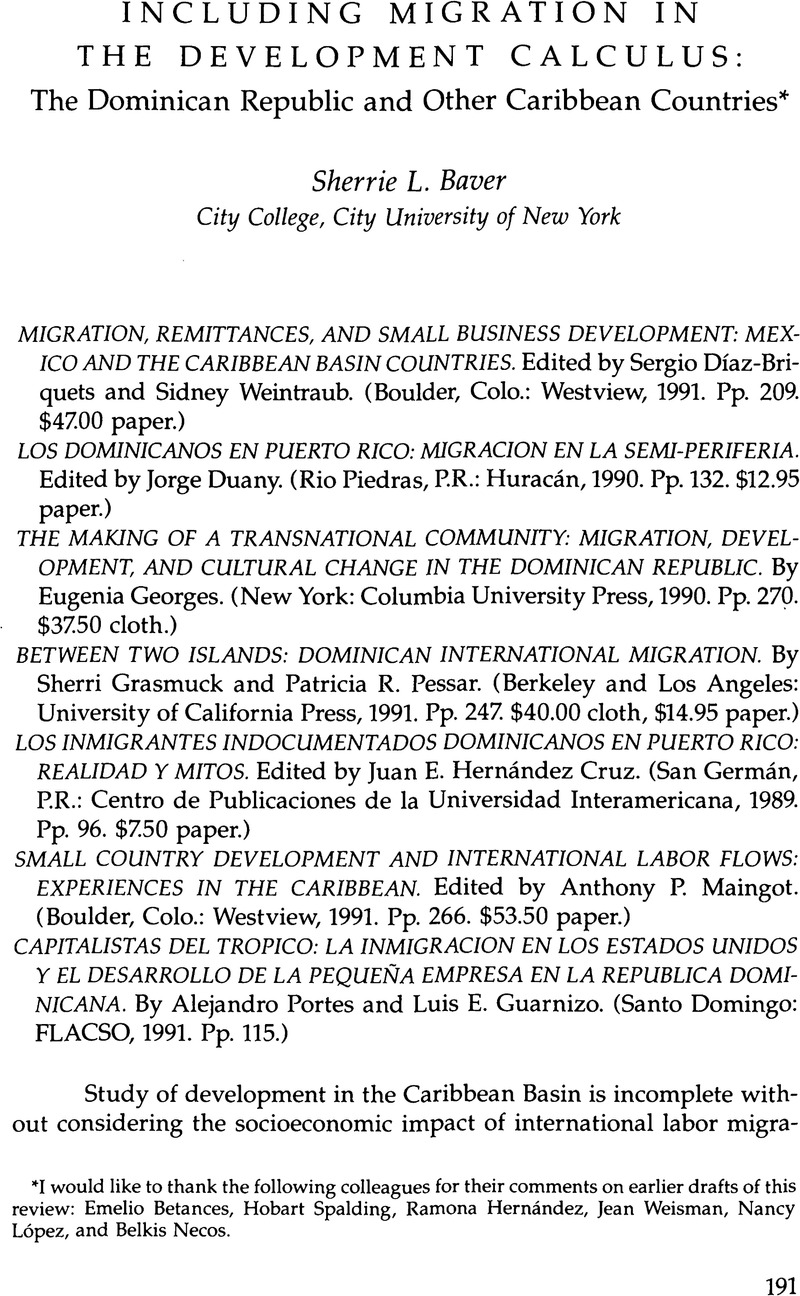Published online by Cambridge University Press: 05 October 2022

I would like to thank the following colleagues for their comments on earlier drafts of this review: Emelio Betances, Hobart Spalding, Ramona Hernández, Jean Weisman, Nancy López, and Belkis Necos.
1. See, for example, Isis Duarte, “Household Workers in the Dominican Republic: A Question for the Feminist Movement?” in Muchachas No More: Household Workers in Latin America and the Caribbean, edited by Elsa Chaney and Mary García Castro (Philadelphia, Pa.: Temple University Press, 1989), 197–219; Helen Safa, “Women and Industrialization in the Caribbean,” in Women, Employment, and Family in the International Division of Labour, edited by Sharon Stichter and Jane Parpart (London: Macmillan, 1990), 72–96; Andrés Dauhaire, hijo, Elizabeth Riley, Rita Mena, and José A. Guerrero, Impacto económico de las zonas francas industriales de exportación en la República Dominicana (Santo Domingo: Fundación Economía y Desarrollo, 1989); and Bernardo Vega, En la década perdida (Santo Domingo: Fundación Cultural Dominicana, 1991).
2. Other researchers have argued that the illegal immigrants in New York City were from backgrounds similar to those of legal migrants because they often came from the same family. See Vivian Garrison and Carol Weiss, “Dominican Family Networks and United States Immigration Policy,” in Caribbean Life in New York City: Sociocultural Dimensions, edited by Constance Sutton and Elsa Chaney (New York: Center for Immigration Studies, 1987), 235–54; and Demetrios Papademetriou and Nicholas DiMarzio, Undocumented Aliens in the New York Metropolitan Area: An Exploration into Their Society and Labor-Market Incorporation (New York: Center for Migration Studies, 1986).
3. David Bray, “The Dominican Exodus: Origins, Problems, Solutions,” in The Caribbean Exodus, edited by Barry Levine (New York: Praeger, 1987), 152–70.
4. See Franc Báez Evertsz, “Migración internacional y política de migración: viejos enfoques y nuevas tendencias,” La Revista de la Facultad de Ciencias Económicas y Sociales, USAD 4 (Jan.–June):45–64.
5. This study was published in English in 1990 as Occasional Paper no. 4 by the Department of Sociology at The Johns Hopkins University.
6. In addition to the work of Pessar, Grasmuck, and Georges, see for example, Franc Báez Evertsz and Francisco D'Oleo, La emigración de dominicanos a Estado Unidos: determinantes socio-económicos y consequencias (Santo Domingo: Editora Taller, 1985); and Douglas T. Gurak and Mary Kritz, “Dominican and Colombian Women in New York City: Household Structure and Employment Patterns,” Migration Today 10, nos. 3–4 (1982):14–21.
7. On the Dominican ethnic enclave in New York, see Roger Waldinger, Through the Eye of the Needle: Immigrants and Enterprises in New York's Garment Trades (New York: New York University Press, 1986).
8. La inmigración dominicana en los Estados Unidos, edited by José del Castillo and Christopher Mitchell (Santo Domingo: Editorial APEC, 1987).
9. Báez Evertsz, “Migración internacional.”